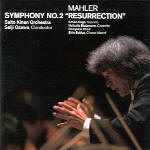Seiji Ozawa’s credentials as a Mahlerian have not received the recognition that they deserve (the same holds true of his Bruckner). His complete symphony cycle recorded in Boston includes two excellent versions of the First Symphony (the one for Deutsche Grammophon slightly better than the later one for Philips), equally superb performances of the Third, Fourth, and Ninth Symphonies, and fine efforts in Nos. 2, 5, 7, and 8. The Sixth would have been very good also had it not been compromised by wretchedly dull recorded sound. Given the fact that Ozawa’s Philips recordings with the Saito Kinen Orchestra have been generally excellent, we might reasonably expect something special from this live Mahler 2, and that’s exactly what we get. This is a stunning performance, magnificently recorded.
Ozawa’s first go at this symphony suffered from, if anything, an excess of polish. It was beautifully played but so smooth as to appear emotionally cool just when the climaxes ought to expand and hit you squarely in the solar plexus. Well, if you have any solar plexus left after this performance, then you’re made of tough stuff indeed. Superb string playing marks vitually all of the Saito Kinen orchestra’s recordings, and this one is no exception. Just listen to the cellos and basses grind away at their angry recitatives throughout the first movement, or the supple, sexy violins at the opening of the second. The similar excellence of the winds and brass comes as a very pleasant surprise. The horns play with noble, ringing tone (in the finale especially), while the trombones have the bite to make something truly menacing out of the great explosion just before the same movement’s “last trump” episode. There are too many fine things to list them all, but suffice it to say that two moments that seemed somewhat inhibited in Ozawa’s last go–the great percussion crescendo in the finale, and the music immediately following the concluding chorus–now have the grandeur and amplitude that the music demands.
Natalie Stutzmann’s “earth mother” vocal timbre suits the “Urlicht” fourth movement perfectly, and the choral forces acquit themselves admirably, singing clearly and with great power where called for. A little more organ at the very end might have given even more weight to Mahler’s cosmic panorama, but it’s still more than we usually get, and the superbly balanced live recording puts nothing between you and the players. A great performance of this symphony must convey a sense of occasion, of importance. It should be an event. This evidently was, and thanks to Sony’s foresight in capturing it live, it always will be.
































